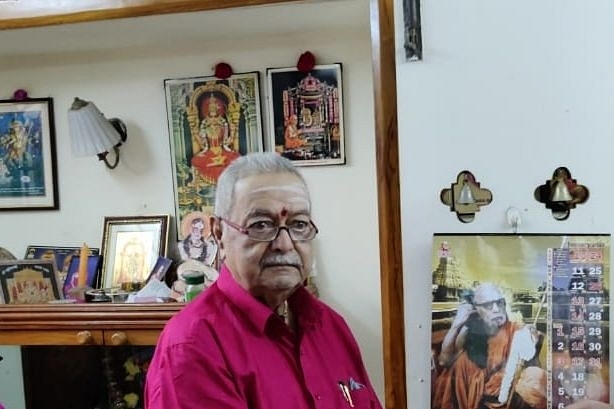Culture
'Chekizhaar Adi Podi' Dr. T.N.Ramachandran (1934-2021): A Tribute
- Dr. T.N.Ramachandran (1934-2021) showed how to fight the forces which want to harm Dharma, and do this in a way that the fight itself becomes spiritual sadhana.

Dr. T.N.Ramachandran (Twitter)
It was an evening in some year of the 1980s.
Some Tamil scholars of Kanyakumari district were having a meeting in our house. The agenda of the meeting was a book titled Thirukural, Saiva Siddhanta and Bible: A Comparative Study.
The book, written by one Deivanayagam, was being published by the International Tamil Research Institute, Chennai.
The book claimed that not only the Thirukural but the entire Saiva Siddhanta had their roots in the Bible which was brought to India by St. Thomas.
Needless to say, this was more fanaticism than scholarship even though the book had pretensions of the latter.
Traditional Saiva Siddhanta scholars were not adept in academic pretensions and jargon and the academicians had no deep knowledge of Saiva Siddhanta.
Then, that evening, a retired professor from Malaysia Dr. B. Arunachalam, a great scholar of Siddhanta and a devotee of Shiva came and announced, ‘Do not worry. Our T.N.R had saved the day.’
I was then in my early teens and that was the first time I heard the name – T.N.R.
An authoritative rebuttal had been published, thanks to the efforts of T.N.Ramachandran Ayya (fondly called TNR) through classical Siddhanta scholar of great repute, Kathirai Vadivel Muthaliyar.
TNR was then the honorary director of the International Saiva Siddhanta Research Institute which published the rebuttal book.
Cut to 2008.
As I was gathering data for Breaking India, I discovered that the old theory of St. Thomas inspiring Saivism was being brought back by the evangelist forces. Soon many got concerned.
In Kumbhakonam, Sri Kannan of the RSS organised a seminar rebutting the old hoaxes and lies. Here, I saw Thiru. T.N.Ramachandran again.
He was an unassuming personality exuding a child-like innocence.
He was suffering from ailments though. His eye sight had been affected by diabetes. Yet, one could see the same fire in him.
His knowledge of not only Saiva Siddhanta but also the Bible was amazing. He explained poignantly how Saiva Siddhanta and the Biblical belief systems are totally incompatible.
He asked the assembled to study the discipline of comparative religions. With folded hands, he requested the Adheenams assembled there to come together against the nefarious attempts to destroy Hinduism.
His library in his Thanjavur home is legendary among all research scholars.
He always held it open for all research scholars – irrespective of their ideological and religious orientation. Many PhD scholars have been benefitted by this educational service of TNR.
He was always on the look out for old lost classics of Saiva Siddhanta and got them reprinted.
His devotion to Chekkizhar, the poet-minister who sang Periya-Purannam was so intense and great that he was called ‘Chekkizhar-Adi-Podi’, meaning TNR considered himself a speck of dust of the feet of Chekkizhar.
He had translated into English Saivaite hymns with such a mastery of both the languages that he could even retain the poetic form in the translations.
Prof. R.E.Asher of the Linguistic Department of the University of Edinburgh had this to say about the translations of TNR:
In 1984, he brought out a compilation of the appreciation of various international scholars of Saiva Siddhanta, through the Dharmapuram Adheenam.
It was on the occasion of the first international Saiva Siddhanta conference. It was a massive work. The preface he wrote to that volume shows the kind of academic integrity as well as the keen insight he had about how missionary-scholars viewed Saiva Siddhanta – from their own missiological agenda. The same preface also described him getting overcome by the sheer spiritual beauty of Siddhanta.
Deeply immersed in Saiva Siddhanta, he crisply explained the greatness of it through simple, eloquent yet deeply spiritually meaningful arguments.
For example, this is how he explained the difference between Saiva Siddhanta and Sankara Advaita:
His deep spirituality was neither other-worldly nor escapist. When he saw missionaries playing mischief through certain distortions by reviving the propaganda that the Vedas mentioned in Saivaite Thirumurais were not Rig, Yajur, Sama and Atharvana, he republished an earlier debate between Dravidianist scholars and traditional Siddhanta scholars.
The latter had earlier vanquished the former. But with cultural illiteracy around these aspects, the old forces of proselytisation had started using the distortions again.
Thankfully we had Dr. TNR who would get the entire authentic Siddhantic rebuttal to such colonial distortions republished, alerting us to the reality.
A lawyer and scholar by profession and a Dharmic warrior by passion, Dr. T.N.Ramachandran (1934-2021) had set an example as to how to live a life in Dharma and fight the forces which want to harm Dharma, in a way that the fight can be made a spiritual sadhana itself.
In his merging with Shiva, we have the loss of his physical form which had always inspired us and guided us with paternal love and wisdom. That is not a simple loss. But his sacred memory shall ever make us work tirelessly for the cause of Vedic Saiva Siddhanta.
Introducing ElectionsHQ + 50 Ground Reports Project
The 2024 elections might seem easy to guess, but there are some important questions that shouldn't be missed.
Do freebies still sway voters? Do people prioritise infrastructure when voting? How will Punjab vote?
The answers to these questions provide great insights into where we, as a country, are headed in the years to come.
Swarajya is starting a project with an aim to do 50 solid ground stories and a smart commentary service on WhatsApp, a one-of-a-kind. We'd love your support during this election season.
Click below to contribute.
Latest